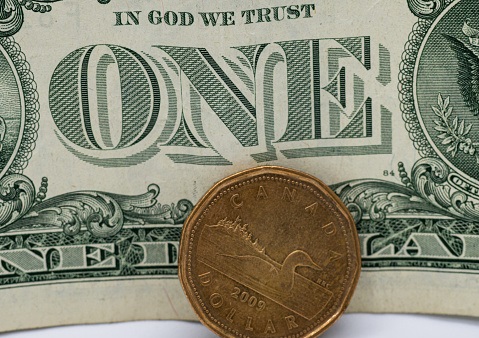US equity markets saw fresh incremental gains to push the major indices to fresh all-time highs yesterday, aided by what most analysts and market commentators described as a dovish sounding Fed Chair Powell, who spoke in at the first of his two-day semi-annual testimony before Congress. The S&P 500 index came within a few points of the 4400 marks, but for the most part continues to trade within the 4360-4390 ranges of recent days. Today E-mini S&P 500 futures have slipped below this range ahead of the US equity cash open, in tandem with some downside being seen in the European equity space (where the Stoxx 600 is down about 0.7%). Market commentators in Europe are citing Covid-19 Delta variant spread concerns, as well as concerns about inflation in wake of much hotter than expected June CPI and PPI reports out of the US, as weighing on sentiment. Others are citing the possibility of some profit-taking/position adjustment as US earnings season gets underway; “after a decent run higher, the U.S. earnings season may well have elements of buying the rumour, selling the fact with lots of good news priced into upcoming results” said analysts at OANDA, before continuing that “still, equities remain near record highs… So, despite the sideways shuffle last night, it really is business as usual”.
Elsewhere, another factor that seems to have at the very least weighed on European equity sentiment (and possibly also US pre-market sentiment) was hawkish commentary from a key member of the Bank of England. Michael Saunders, who is a member of the BoE’s Monetary Policy Committee said that “it may become appropriate soon to withdraw some of the current monetary stimulus”. In this case, he continued, options could include ending the bank’s QE programme in the next month or two and before the full £150B gilt purchase remit has been utilised. He also hinted at rate hikes in the “next year or so”, though that any rise in interest rates would be relatively small. The impact of this hawkish sentiment has also had an impact on FX and bond markets; GBP is the best performing of the G10 currencies this morning, though this has only translated into modest gains for GBPUSD, which continues to struggle to break back to the north of the 1.3900 level, as further gains are hampered by a resilient US dollar. Meanwhile, the UK bond yield curve has seen quite a sharp steepening, with 2-year yields jumping 5bps to nearly 0.14% and 10-year yields up about 2.5bps (quite big moves for the usually subdued UK gilt market). This bucks the broader trend of yields moving lower in the rest of Europe and US, with analysts citing dovish vibes from the Fed Chair as easing concerns about imminent monetary policy tightening from the world’s most important central bank, as well as an easing of concerns about long-term inflationary pressures. US 10-year yields are down just under 3bps this morning and are back around 1.33% having briefly gone above 1.40% earlier in the week. 10-year TIPS yields, meanwhile, have been getting some attention given they have fallen under -1.0% again and to fresh multi-month lows. This has helped spot gold prices to break away from the magnetic grip of the $1800 level, with the precious metal now trading on spot markets in the upper/mid $1820s, its highest level since mid-June (the immediate aftermath of the FOMC’s hawkish dot-plot shift).
Sticking with commodities; crude oil prices are taking another hit this Thursday, with WTI down a further 1.5% following on from yesterday’s roughly 3.0% losses. That means that front-month WTI futures have fallen below the $72.00 handle again and look close to challenging monthly lows in of just under $71.00. Demand side concerns are being cited as one factor weighing on crude oil prices; the spread of the Covid-19 delta variant continues to accelerate in Europe, and it looks as though international travel restrictions may not be eased as promptly as hoped a few weeks ago (a blow to jet fuel demand expectations). Meanwhile, in terms of crude oil supply-side fundamentals, the main news yesterday was that the UAE and Saudi Arabians had reached agreement over allowing a boost to the former’s baseline production level (from which output cuts are calculated) from April 2022 (when the cartel’s current deal is set to expire). This had been the major stumbling block to a deal being reached at the recent OPEC+ meeting on the cartel extending its current output pact until the end of 2022, as well as preventing an agreement on cartel output hikes between now and the end of the year. This tees up an agreement on an output hike from August and into the rest of the year – analysts are citing this as weighing on crude oil prices over the last two days. However, reports indicate that other countries (such as Iraq) now also want their baseline production level increased from April 2022 and now that the UAE has been granted a boost to its baseline from this date, it seems likely other OPEC+ producers beyond Iraq will request the same. The risk of another impasse at the next OPEC+ meeting remains elevated. Elsewhere, it appears that indirect US/Iran talks on a potential return in compliance to the 2015 JCPOA nuclear deal are on ice for the foreseeable future, with Iran reportedly not prepared to resume talks until the country’s new President has taken charge. It seems the US is willing to wait for now.
Finally, looking at FX markets; the US dollar has seen some fluctuations in recent days, with DXY rallying from the low 92.00s to the upper 92.00s on Tuesday in wake of higher-than-expected US CPI and then falling from the upper 92.00s back to around the 92.50 mark on Wednesday in wake of “dovish” Fed Chair Powell remarks. This is where the index continues to consolidate today, well within recent ranges, though a little firmer on the day amid weakness elsewhere. As noted above, most market commentators and analysts found Powell’s remarks in the first of his two-day testimony to be net-net dovish. Recapping some of the key remarks, Powell said; that the US economy remains “still a ways off” from where it needs to be for the bank to announce a tapering of its bond buying programme (i.e. that substantial progress towards the Fed’s goals, the condition for QE tapering, has not yet been met), whilst also reiterating that he is confident that the spike in prices being observed in the US economy right now will be transitory.
Elsewhere, FX market participants keenly watched as key Chinese economic data was released overnight. The data, which was mixed, did not seem to have had much of an impact on broader risk appetite; Chinese GDP growth in Q2 2021 came in a little slower than expected and at an annualised quarterly pace of 5.3%, is slow by historical standards. However, the YoY growth rates of Industrial Production and Retail Sales in the month of June were both a little higher than expected (at 8.3% and 12.1% respectively), allaying some concerns that the Chinese economy continued to slow heading into the end of the final month of Q2. Some analysts argue that headwinds to growth are likely to intensify later in the year as global consumption patterns switch towards consumption of services rather than of physical goods, which likely implies China’s export boom of the last year or so has peaked. Based on the above logic, many analysts expect further easing from the PBoC and perhaps fiscal authorities. It seems likely that uncertainty over Chinese growth could act as a headwind for the CNY in the near-term, something that could also weigh on the currencies of China-linked economies such as AUD and NZD. Indeed, both are a fair amount weaker on the session, down about 0.4% each versus the buck, pushing AUDUSD back towards 0.7450 and NZDUSD back to the 0.7000 handle. The latter pair is likely to continue to derive support from this week’s hawkish RBNZ vibes, however. The Aussie, meanwhile, has largely failed to garner much of a boost from a strong June jobs report, which saw healthy gains in full-time employment and a larger than expected drop in the unemployment rate to below 5.0%.
Looking elsewhere in the G10; GBP outperforms for the reasons detailed above (hawkish BoE vibes), which have helped the currency shrug off what was a somewhat underwhelming UK labour market report for the month of June this morning. Meanwhile, CHF, EUR and CAD are each down about 0.2% on the day versus the buck, trading more as a function of global FX flows rather than on any domestic drivers. The BoC did not deliver any surprises at its monetary policy meeting yesterday, at which it held interest rates but reduced the monthly rate of asset purchases from CAD 3B to CAD 2B as expected.
The Day Ahead
US Weekly Jobless Claims data is out at 1330BST and is worth watching, as usual, given it can impact risk appetite. Perhaps more importantly is the release of two regional Fed manufacturing surveys (from NY and Philadelphia), also at 1330BST, which both serve as one of the earliest indicators as to how the US economy is performing so far this month. US Industrial Production data for the month of June is then out at 1415BST and then the focus will be back on Fed Chair Powell for his second day of testimony (set to begin at 1430BST).




